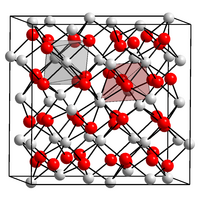
Photo from wikipedia
Metal oxides are commonly used in optoelectronic devices due to their transparency and excellent electrical conductivity. Based on its physical properties, each metal oxide serves as the foundation for a… Click to show full abstract
Metal oxides are commonly used in optoelectronic devices due to their transparency and excellent electrical conductivity. Based on its physical properties, each metal oxide serves as the foundation for a unique device. In this study, we opt to determine and assess the physical properties of MoO3 metal oxide. Accordingly, the optical and electronic parameters of MoO3 are evaluated using DFT (Density Functional Theory), and PBE and HSE06 functionals were mainly used in the calculation. It was found that the band structure of MoO3 calculated using PBE and HSE06 exhibited indirect semiconductor properties with the same line quality. Its band gap was 3.027 eV in HSE06 and 2.12 eV in PBE. Electrons and holes had effective masses and mobilities of 0.06673, −0.10084, 3811.11 cm2V−1s−1 and 1630.39 cm2V−1s−1, respectively. In addition, the simulation determined the dependence of the real and imaginary components of the complex refractive index and permittivity of MoO3 on the wavelength of light, and a value of 58 corresponds to the relative permittivity. MoO3 has a refractive index of between 1.5 and 3 in the visible spectrum, which can therefore be used as an anti-reflection layer for solar cells made from silicon. In addition, based on the semiconducting properties of MoO3, it was estimated that it could serve as an emitter layer for a solar cell containing silicon. In this work, we calculated the photoelectric parameters of the MoO3/Si heterojunction solar cell using Sentaurus TCAD (Technology Computing Aided Design). According to the obtained results, the efficiency of the MoO3/Si solar cell with a MoO3 layer thickness of 100 nm and a Si layer thickness of 9 nm is 8.8%, which is 1.24% greater than the efficiency of a homojunction silicon-based solar cell of the same size. The greatest short-circuit current for a MoO3/Si heterojunction solar cell was observed at a MoO3 layer thickness of 60 nm, which was determined by studying the dependency of the heterojunction short-circuit current on the thickness of the MoO3 layer.
Journal Title: Nanomaterials
Year Published: 2022
Link to full text (if available)
Share on Social Media: Sign Up to like & get
recommendations!